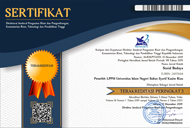Memperkenalkan Pariwisata Budaya dan Heritage Kepada Generasi Muda Melalui Virtual Tour ke Pulau Penyengat
Abstract
Kondisi pandemic yang melanda Indonesia yang memaksa masyarakat untuk tetap berada dirumah demi mencegah penyebaran virus corona dimanfaatkan oleh sekelompok masyarakat untuk berkegiatan untuk mengatasi rasa bosan. Wisata virtual ke Pulau Penyengat yang merupakan destinasi pariwisata budaya dan heritage yang diadakan oleh Outing.id diikuti oleh 32 orang wisatawan virtual yang 22 orangnya merupakan peserta yang berusia 21 – 40 tahun yang lazim dikenal dengan generasi millennial. Dengan menggunakan metode penelitian kualitatif deskriptif dengan pengambilan data menggunakan metode survei dengan pedekatan purposive sampling, peneliti bertujuan ingin mengetahui karakteristik dan motivasi para millennial dalam mengikuti virtual tour wisata budaya dan heritage ke Pulau Penyengat di Provinsi Kepulauan Riau. Hasilnya para peserta millennial yang mengikuti kegiatan ini didorong karena rasa ingin tahu terhadap destinasi pariwisata yang disajikan secara daring dalam bentuk virtual tour melalui aplikasi video conference.
Keywords
Full Text:
PDFReferences
Aditya, N. (2020). 5 fakta tren wisata generasi milenial Indonesia pada 2019. Kompas.Com. https://travel.kompas.com/read/2020/01/16/061800327/5-fakta-tren-wisata-generasi-milenial-indonesia-pada-2019?page=all
Bekk, M., Spörrle, M., & Kruse, J. (2016). The Benefits of Similarity between Tourist and Destination Personality. Journal of Travel Research, 55(8), 1008–1021. https://doi.org/10.1177/0047287515606813
Cho, Y. H., Wang, Y., & Fesenmaier, D. R. (2002). Searching for experiences: The web-based virtual tour in tourism marketing. Journal of Travel and Tourism Marketing, 12(4), 1–17. https://doi.org/10.1300/J073v12n04_01
Creswell, J. W. (2019). Research Design: Qualitative, Quantitative and Mixed Methods Approaches (4th ed.). English Language Teaching, 12(5).
Jan, D., Roque, A., Leuski, A., Morie, J., & Traum, D. (2009). A virtual tour guide for virtual worlds. Lecture Notes in Computer Science (Including Subseries Lecture Notes in Artificial Intelligence and Lecture Notes in Bioinformatics), 5773 LNAI, 372–378. https://doi.org/10.1007/978-3-642-04380-2_40
Jiang, X., & Homsey, A. (2008). Heritage Tourism Planning Guidebook Methods for Implementing Heritage Tourism Programs in Sussex County, Delaware A product of the Coastal Community Enhancement Initiative. www.ipa.udel.edu
Khairunnas, J., & Harun, I. (2015). Inventarisasi Naskah Klasik Kerajaan Lingga. In Sosial Budaya (Vol. 11, Issue 1). www.kepriprov.go.id.
Moore, M. (2012). Interactive media usage among millennial consumers. Journal of Consumer Marketing, 29(6), 436–444. https://doi.org/10.1108/07363761211259241
Orbaslı, A., & Woodward., S. (2009). Tourism and heritage conservation. In The SAGE handbook of tourism studies (p. 314). SAGE Publications Ltd.
Park, D. B., & Yoon, Y. S. (2009). Segmentation by motivation in rural tourism: A Korean case study. Tourism Management, 30(1), 99–108. https://doi.org/10.1016/j.tourman.2008.03.011
Richards, G. (1999). Culture, Cultural Tourism and Identity. Conference on Sustainable Tourism Development in the Wadden Sea Region, 53(9), 1689–1699. https://www.academia.edu/5129674/Culture_Cultural_Tourism_and_Identity
Richards, G. (2013). Tourism development trajectories: From culture to creativity? In The Routledge Handbook of Cultural Tourism. https://doi.org/10.4324/9780203120958
Sadq, Z. M., Othman, B., & Khorsheed, R. K. (2019). The impact of tourism marketing in enhancing competitive capabilities. African Journal of Hospitality, Tourism and Leisure, 8(5). http//:www.ajhtl.com
Sangchumnong, A., & Kozak, M. (2018). Sustainable cultural heritage tourism at Ban Wangka Village, Thailand. Anatolia, 29(2), 183–193. https://doi.org/10.1080/13032917.2017.1414435
Smith, M. K. (2015). Issues in cultural tourism studies: Third edition. In Issues in Cultural Tourism Studies: Third Edition (1st Editio). Routledge. https://doi.org/10.4324/9781315767697
Timothy, D. J. (2011). Cultural heritage and tourism: An introduction. In Cultural Heritage and Tourism: An Introduction. https://doi.org/10.15291/lib.992
tom Dieck, M. C., & Jung, T. (2018). A theoretical model of mobile augmented reality acceptance in urban heritage tourism. Current Issues in Tourism, 21(2), 154–174. https://doi.org/10.1080/13683500.2015.1070801
UNWTO. (2008). Youth Travel Matters – Understanding the Global Phenomenon of Youth Travel. In Youth Travel Matters – Understanding the Global Phenomenon of Youth Travel. World Tourism Organization (UNWTO). https://doi.org/10.18111/9789284412396
UNWTO. (2013). UNWTO Tourism Highlights, 2013 Edition. In UNWTO Tourism Highlights, 2013 Edition. World Tourism Organization (UNWTO). https://doi.org/10.18111/9789284415427
Utomo, W. P., Lubis, U. Z., & Sudradjat, S. A. (2019). Indonesia millennial report 2019.
Van Der Merwe, C. D. (2016). Tourist guides’ perceptions of cultural heritage tourism in South Africa. Bulletin of Geography, 34(34), 117–130. https://doi.org/10.1515/bog-2016-0039
WYSETC. (2016). Affiliate Members Global Report: Volume 13 - The power of youth travel. In Affiliate Members Global Report: Volume 13 - The power of youth travel.
DOI: http://dx.doi.org/10.24014/sb.v17i2.11010
Refbacks
- There are currently no refbacks.
Published by:
Center for Research and Community Development
Universitas Islam Negeri Sultan Syarif Kasim Riau
Jl. H. R. Soebrantas KM 15,5 ,Tuah Madani, Tampan,
Pekanbaru, Riau 28293
Indexed By:


.jpg)



